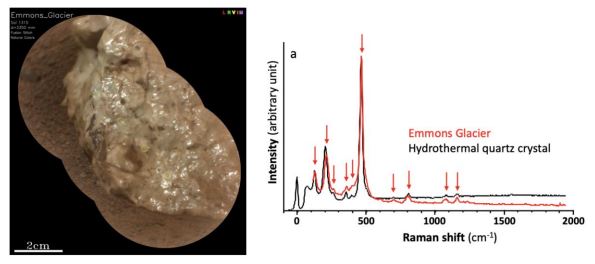Quartz discovered for the first time on Mars by the Perseverance rover, attesting to ancient water circulation on the Red Planet
An international research team involving a number of French laboratories (1), including the Institut de planétologie et d’astrophysique de Grenoble (OSUG – CNRS/UGA), the Institut de minéralogie, de physique des matériaux et de cosmochimie (CNRS/MNHN/Sorbonne Université), the Laboratoire de géologie de Lyon (CNRS/ENS Lyon/Univ. Claude Bernard/UJM Saint-Etienne) and the Institut de recherche en astrophysique et planétologie (CNRS/CNES/Université de Toulouse) have just identified, thanks to the NASA rover Perseverance, rocks that bear witness to ancient water circulation. This discovery was published in the journal Earth and planetary science letters on February 28, 2025.
For the past 4 years, the Perseverance rover has been surveying the surface of Mars, with the aim of understanding the geology of the Jezero impact crater, and sampling selected rocks with a view to returning to Earth. After studying the magmatic rocks on the crater floor and the sedimentary deposits of an ancient delta deposited on top of them, the rover climbed the crater ramparts. A series of rocks with very specific chemical and mineralogical compositions were found. They bear witness to water-rock interaction dating back to the very beginning of Mars’ history.
This discovery was made by an international scientific team using the SuperCam instrument package (2). SuperCam was able to identify rocks rich in silica, and composed of different forms of silica: opal (known on Earth for its iridescent properties), chalcedony (a form of quartz with very small crystals), and finally perfectly crystallized quartz. While quartz is common in the Earth’s crust, this is the first time this mineral has been identified directly on the surface of the Red Planet, thanks to the Raman spectroscopy deployed by SuperCam. To dissolve and precipitate silica, the existence of hydrothermal processes can be proposed, as these are common on Earth at the edges of impact craters. The energy supplied by cratering and associated deformation provides heat, promoting fluid circulation within fractured rocks.

These rocks therefore bear witness to very ancient water circulation on Mars, and are interesting from an exobiological point of view. Siliceous rocks, and opal in particular, have a remarkable capacity to preserve traces of life, whether morphological or molecular. If Perseverance succeeds in sampling this type of rock, it will be a prime target for the search for signatures of life once brought back to Earth.
“With this publication, we demonstrate the presence of different silica phases, and this is the first identification from the surface of Mars of an “iconic” mineral, quartz, with the most beautiful “Raman” spectrum ever measured anywhere other than on Earth, almost 100 years after the discovery of the technique. We also detected other forms of silica: opal and chalcedony. All this points to a very ancient hydrothermal system, and these rocks are particularly interesting from an exobiology point of view, as silica is a very effective material for preserving signatures of the living world”, comments Pierre Beck, a professor at the Université Grenoble Alpes (UGA) carrying out his research at IPAG.
“Observing traces of an ancient hydrothermal system linked to an impact crater on the surface of Mars is particularly remarkable, as hydrothermal environments are among the main targets for the search for microbial life in the Solar System. The surface of Mars is riddled with impact craters: it’s entirely possible that similar environments may have been quite common on the Red Planet,” adds Lucia Mandon, a postdoctoral fellow at the French space agency CNES, who is also carrying out her research at IPAG.
Notes
- Laboratoire Atmosphères, Milieux, Observations Spatiales (LATMOS-IPSL/CNRS / Sorbonne Univ / UVSQ) ; Institut de recherche en astrophysique et planétologie (IRAP – OMP – CNRS/CNES/Univ.Toulouse III Paul Sabatier) ; Institut de planétologie et d’astrophysique de Grenoble (IPAG – OSUG -CNRS / UGA) ; Laboratoire d’astrophysique de Marseille (LAM – CNRS/CNES/Aix Marseille Université) ; Laboratoire de géologie de Lyon : Terre, Planètes, Environnement (LGL-TPE – OSUL -CNRS/ENS Lyon/Univ. Claude Bernard/UJM Saint-Etienne) ; Laboratoire d’instrumentation et de recherche en astrophysique (LIRA – Obs de Paris-PSL/CNRS /Sorbonne Univ/Univ Paris Cité ) ; Institut d’Astrophysique spatiale (IAS – CNRS/Univ. Paris Saclay) ; Institut de Minéralogie, de Physique des Matériaux et de Cosmochimie (IMPMC – CNRS/MNHN/Sorbonne Univ) ; Laboratoire de Planétologie et Géosciences de Nantes (LPGN – CNRS/Univ. Nantes)
- This highly innovative instrument package was developed jointly by a consortium of French laboratories led by IRAP (Toulouse, France), LANL (Los Alamos, USA), and with a contribution from the University of Valladolid (Valladolid, Spain). CNES is responsible to NASA for the French contribution to SuperCam. CNES, CNRS and a number of universities have contributed human resources to the supply of this instrument, and the instrument is operated alternately by the European team through the control center installed at CNES in Toulouse (FOCSE Mars 2020), and by the American team from LANL.
Further Resources
- Scientific Publication : From hydrated silica to quartz: Potential hydrothermal precipitates found in Jezero crater, Mars by P. Beck, O. Beyssac, E. Dehouck, S. Bernard, M. Pineau, L. Mandon, C. Royer, E. Clavé, S. Schröder, O. Forni, R. Francis, N. Mangold, C.C. Bedford, A.P. Broz, E.A. Cloutis, J.R. Johnson, F. Poulet, T. Fouchet, C. Quantin-Nataf, C. Pilorget, W. Rapin, P.-Y. Meslin, T.S.J. Gabriel, G. Arana, J.M. Madariaga, A.J. Brown, S. Maurice, S.M. Clegg, O. Gasnault, A. Cousin, R.C. Wiens, the SuperCam team, Earth and planetary science letters, février 2025
IRAP Contacts
- Olivier Forni, olivier.forni@irap.omp.eu
- William Rapin, william.rapin@irap.omp.eu
- Pierre-Yves Meslin, pierre-yves.meslin@irap.omp.eu
- Sylvestre Maurice, sylvestre.maurice@irap.omp.eu
- Olivier Gasnault, olivier.gasnault@irap.omp.eu
- Agnès Cousin, agnes.cousin@irap.omp.eu






